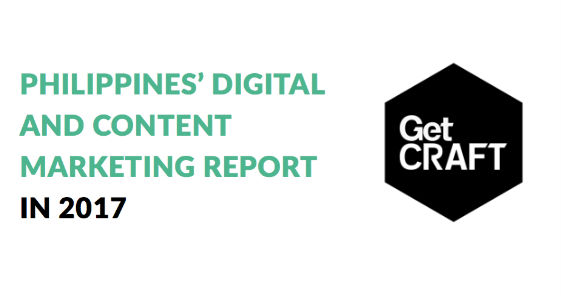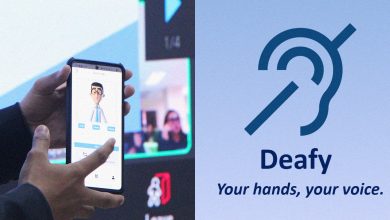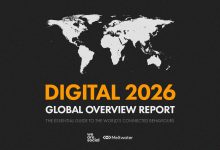By Bong R. Osorio
A white paper on the State of Digital Marketing and digital marketing trends in the Philippines was presented by GetCRaft, Southeast Asia’s premier content marketing network last July 26 in Square One, Bonifacio Technological Center, BGC. The market inquiry brings together data and insights culled from a survey conducted in 2017 of marketers across major cities in the Philippines, involving 150 respondents — managers, directors, vice-presidents and C-level marketers from brands and agencies representing various industries.
The report seeks to deliver impartial digital and content marketing industry snapshots and entreats ideas on pushing these findings forward. The goal is to inform the readers about the current state of digital and content marketing in the Philippines, identify pain points among marketers, and explore solutions. Here are the highlights of the study:
Market overview of the Philippines’ digital landscape
Total Philippine population is 117 million, 85.16 million of whom are Internet users, and 84.45 million are active social media users. Mobile subscriptions number 168.3 million, while active mobile social users are 94 million. On device usage: 97.3% use any type of mobile phone; 96.3% utilize smart phone; 64.8% and 28.1% avail of laptop or computer and tablet respectively. Average daily use: 32.53% of the day on their phones, 21.91% on computers, 21.91% browsing social media, and 8.75% percent of the time playing games.

Digital marketing channels used
Social media continues to dominate digital marketing in the Philippines, but content marketing, influencer marketing, and sponsored content are on the rise. Brands view social media—both paid and organic—as the most effective digital channel for marketing, due to the high number of active users, the enormous amount of time users spend using the channel, and cost efficiency. Social media in the Philippines is used for searching and online shopping in the Philippines by nearly a third of the population, with Facebook as the priority medium.
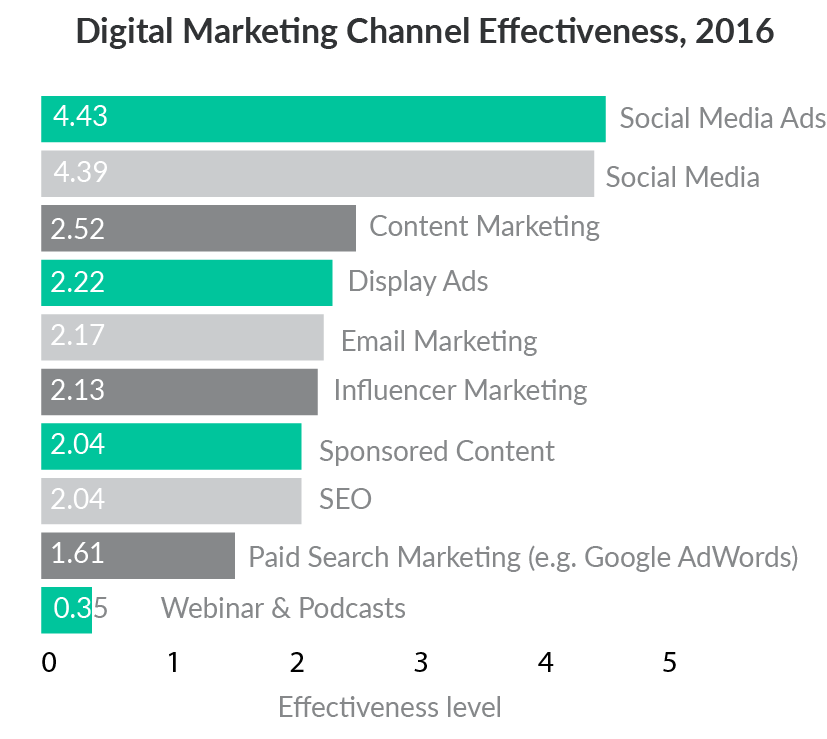
Shayne Garcia, managing Director of iProspect shares, “No one can underestimate the power of social media in the Philippines; this is where we interact with customers, respond to their inquiries and even get real time feedback about product quality. As consumers are deepening more and more their footprint on social, so should marketers.”
Three channels—content marketing, influencer marketing, sponsored content—are not far behind social media in marketers’ priority lists. Companies and brands who want to succeed in social media marketing should understand that one of its critical pillars is content. Pao Pena, Chief Experience Officer at Dentsu Jayme Syfu, stated, “Many brands are jumping on influencers as source of content primarily because we are selling them as paid media and sometimes without proper guidance on whether they truly add value to the marketing mix.”
With the rise of new technologies. Philippine companies and brands have also embraced the power of AI to revolutionize content creation. By leveraging artificial intelligence technologies, they have been able to generate compelling and personalized content at scale. This digital marketing trend can be expected to grow over the years and become one of the most used tools by digital marketers.
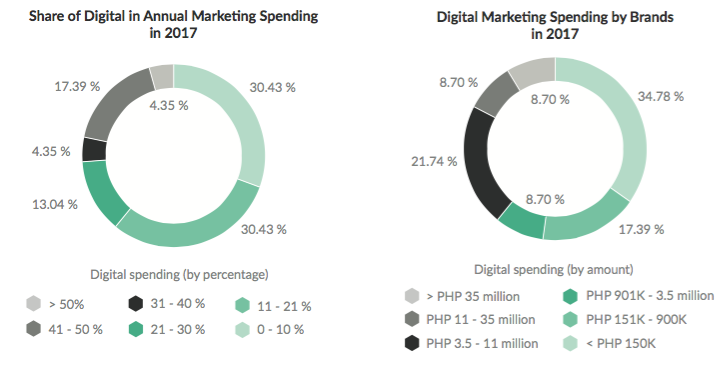
Digital marketing budget
Philippine digital marketing professionals spend 21.5% of their budget on digital marketing trends and strategies. The drivers behind this growth are mostly demographic: increasing consumerism, an emerging middle class, and rapid mobile youth penetration.
The digital marketing economy in 2022 onwards will be buoyed by improved technological infrastructure, internet penetration and broadband speed. Increase in knowledge will also positively impact growth. As marketers better understand the models that allow them to best hit their targets, digital channels will increasingly be viewed as more cost-effective, encouraging brands and agencies to spend more on digital.
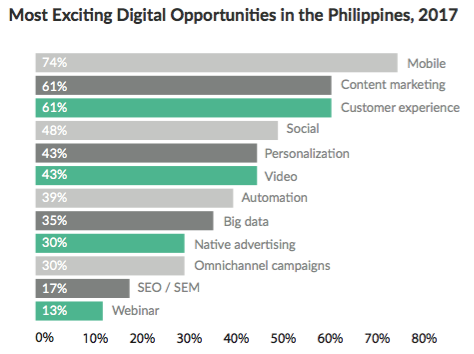
Growth of mobile marketing
Mobile marketing is expected to reign, with content marketing and customer experience as the next promising areas. Marketers are putting priority on how customers experience their brands throughout the customer journey. Rightly so as customer experience is critical in either strengthening or weakening purchasing intent, engagement, brand loyalty and brand advocacy. There are many ways for marketers to improve customer experience including using automation tools, data-powered customization, and prioritizing mobile.
The growing audience of mobile makes it an ideal platform for brands to engage customers through intensified content marketing and enhanced customer experience. But consuming content is only one of three digital behaviors active mobile users engage in. They are also content creators and curators, which presents an opportunity for brands to co-create content with their customers.
Emphasis on content places the onus on marketers to ensure high-quality material that target the right audiences in the right spots. This highlights the need for personalization—or the ability of brands and messages to adapt to consumers. Such an ability is crucial not only in creating and publishing content but also in improving customer experience.
Additionally, TikTok has become a driving force in the growth of mobile marketing, attracting a massive user base and offering unique opportunities for brands to engage with their target audience. With TikTok advertising revenue on the rise, brands can leverage the platform’s dynamic video-sharing features, creative filters, and engaging challenges to build brand awareness and connect with younger demographics. By crafting authentic and entertaining content, collaborating with influencers, and utilizing TikTok’s advertising tools, brands can tap into the platform’s viral potential and maximize their reach in the mobile marketing landscape.
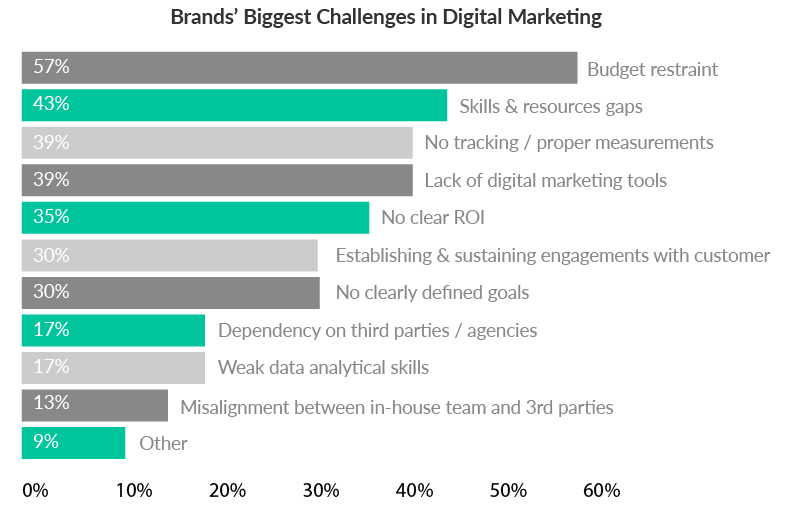
The challenges of digital campaign financing
Budget restraint is a top digital challenge. Even as the value of digital marketing trends in the Philippines grows, nearly three out of five marketers say they have difficulty in getting financing for their digital campaigns. And besides funding, they lack skills and resources, proper tracking or measurements methods, and digital marketing tools.
As there is no one-size-fits-all formula for return on investment (ROI), marketers often struggle to justify their budget requests. This issue highlights the need to solidify key performance indicators. Without ROI tracking, no ROI can be demonstrated, and without ROI, no budget request is justified.
Budget restraints prevent companies from hiring the right people and, therefore, from getting strategies right. Skills shortfall is aggravated by the fact that innovation is at a pace unmatched by learning curves and skills available in the market. Carlo Ople, vice-president for digital marketing strategy of PLDT-Smart states, “To unlock digital spend, marketers need to stop pushing campaign budgets, and instead propose new analytics-driven business.”
Philippine digital marketing and businesses
57% of marketers are unsure about how digital marketing drives business objectives. Lack of clarity about the role digital marketing plays in a business highlights the need to intensify education and training among brands. These efforts must involve not only those in the boardroom but the entire marketing team and other teams they work with.
Difficulties in gauging digital performance and its effect on eCommerce in Southeast Asia could mean that marketers are measuring too many, too few, or incorrect metrics. “Business transformation is key in adapting to the changes of today. However, many are still grappling due to the lack of a seamless strategic view,” said says Eduardo Mapa, Jr., Ffounder of Castle by the River.
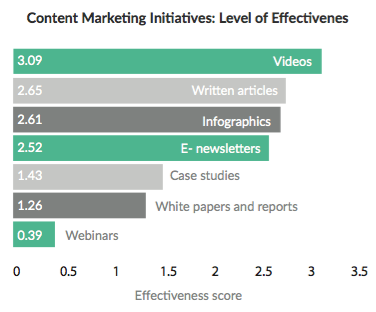
Video content marketing
Videos lead the way in content marketing. As Filipinos spend more time on social media than in watching television, they are also increasingly watching videos from mobile screens.
Global Webb index reports YouTube as the second most active media platform at 56%, topped only by Facebook. Of all Filipino netizens, 28% watch videos online daily; 21% weekly and 19% monthly. A clear factor driving online video consumption growth is the rise of mobile in the Philippines with 57% of the population watch videos online using mobile phones.

